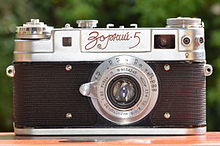
A rangefinder camera is a camera fitted with a rangefinder, typically a split-image rangefinder: a range-finding focusing mechanism allowing the photographer to measure the subject distance and take photographs that are in sharp focus.
Kiev is a Soviet and Ukrainian brand of photographic equipment including cameras manufactured by the Arsenal Factory in Kyiv, Ukraine. The camera nameplates show the name "KIEV", with older cameras using "КИЕВ" or "КИЇВ" in Cyrillic.
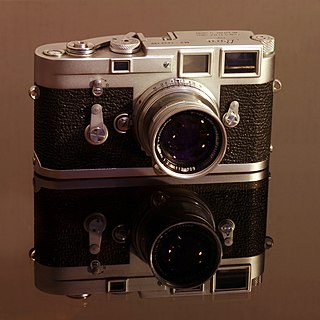
The Leica M3 is a 35 mm rangefinder camera by Ernst Leitz GmbH, introduced in 1954. It was a new starting point for Leitz, which until then had only produced screw-mount Leica cameras that were incremental improvements to its original Leica (Ur-Leica). The M3 introduced several features to the Leica, among them the combination of viewfinder and rangefinder in one bright window, like on the Contax II, a bayonet lens mount, and rapid film advance lever. It was the most successful model of the M series, with over 220,000 units sold by the time production of the M3 model ended in 1966.
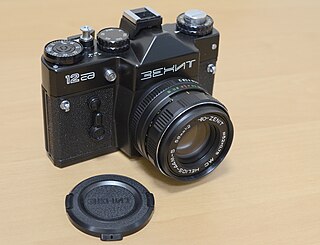
Zenit (Russian: Зени́т) is a Soviet camera brand manufactured by KMZ in the town of Krasnogorsk near Moscow since 1952 and by BelOMO in Belarus since the 1970s. The Zenit trademark is associated with 35 mm SLR cameras. Among related brands are Zorki (Watchful) for 35 mm rangefinder cameras, Moskva (Moscow) and Iskra (Spark) for medium-format folding cameras and Horizon for panoramic cameras. In the 1960s and 1970s, they were exported by Mashpriborintorg to 74 countries.
The Olympus OM System was a line of 35mm single-lens reflex cameras, lenses and accessories sold by Olympus between 1972 and 2002. The system was introduced by Olympus in 1972. The range was designed by Yoshihisa Maitani, chief designer for Olympus, and his staff; OM stands for Olympus Maitani.

The Olympus OM-1 is a manually operated 35mm single-lens reflex camera. It is part of the Olympus OM system.

The LOMO LC-A is a fixed lens, 35 mm film, leaf shutter, zone focus, and compact camera introduced in 1984. Its design is based on the Cosina CX-2, with the difference being that it lacks a swiveling front and self-timer. It was built in Soviet-era Leningrad by Leningrad Optics and Mechanics Association (LOMO).
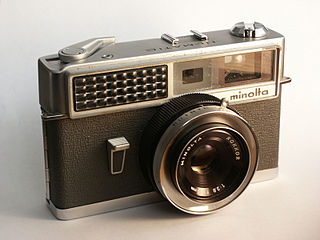
Hi-Matic was the name of a long-running series of 35 mm cameras made by Minolta. The original Hi-Matic of 1962 was the first Minolta camera to feature automatic exposure and achieved a small degree of fame when a version was taken into space by John Glenn in 1962.
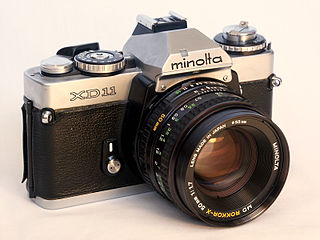
The Minolta XD-7 is a 35mm SLR film camera manufactured by Minolta from 1977 until 1984.

Retina was the brand-name of a long-running series of German-built Kodak 35mm cameras, produced from 1934 until 1969. Kodak Retina cameras were manufactured in Stuttgart-Wangen by the Kodak AG Dr. Nagel Werk which Kodak had acquired in December 1931.

The Konica Hexar RF is a 35 mm rangefinder camera which was sold by Konica. It was introduced to the market on 13 October 1999. and subsequently discontinued some time before the end of 2003. The camera used the "Bayonet Konica KM-mount", a copy of the Leica M-mount, thus sharing interchangeable lenses with those designed for Leica cameras and others compatible with them. The Hexar RF has a combined rangefinder/viewfinder modeled on that of Leica cameras, a similar body shape and size - and so is similar to Leica M-mount cameras in many aspects of operation.

The Konica Hexar is a 35 mm fixed-lens, fixed focal length autofocus camera which was produced through the 1990s. It was introduced to the market in 1993. While styled like a rangefinder camera, and intended for a similar style of photography, in specification it is more like a larger "point and shoot" camera.

The Bessa family of cameras was manufactured in Japan by Cosina as a revival of the Voigtländer brand name between 1999 and 2015.

The FED 2 was a 35 mm rangefinder camera introduced in 1955 by FED. The name of FED comes from the initial of Felix Edmundovich Dzerzhinsky.
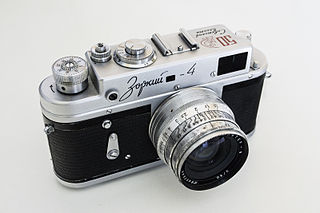
The Zorki 4 was possibly the most popular of all Zorki cameras, with 1,715,677 cameras made by the KMZ factory in Krasnogorsk, Russia. The Zorki 4 was also the first of the Zorki cameras to be exported in large numbers to the west. It is a fully manual camera, and does not have a lightmeter. An additional lightmeter may be added by the cold shoe.

The Contaflex series is a family of 35mm Single-lens reflex cameras (SLR) equipped with a leaf shutter, produced by Zeiss Ikon in the 1950s and 1960s. The name was first used by Zeiss Ikon in 1935 for a 35mm Twin-lens reflex camera, the Contaflex TLR; for the earlier TLR, the -flex suffix referred to the integral reflex mirror for the viewfinder. The first SLR models, the Contaflex I and II have fixed lenses, while the later models have interchangeable lenses; eventually the Contaflexes became a camera system with a wide variety of accessories.
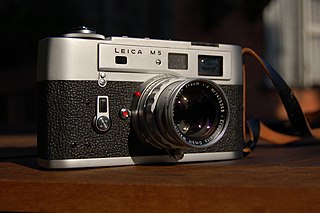
The Leica M5 is a 35 mm camera by Leica Camera AG, introduced in 1971. It was the first Leica rangefinder camera to feature through-the-lens (TTL) metering and the last to be made entirely in Wetzlar by hand using the traditional "adjust and fit" method.

The Kodak Retina Reflex is a discontinued series of four single-lens reflex cameras made by Kodak in Germany between 1957 and 1974, as part of the Kodak Retina line of 35mm film cameras.

A selenium meter is a light-measuring instrument based on the photoelectric properties of selenium. The most common use of such light meters is measuring the exposure value for photography. The electric part of such a meter is an electromagnetic measuring instrument which is connected to the anode and cathode of a selenium photo cell that produces more or less electric power when exposed to more or less light. The optical part of such a meter is a window in front of the photo cell's light-sensitive side. The window's surface is usually structured like a honeycomb made of convex lenses. This type of window helps to bundle the light coming from the direction in which the photo cell is pointed. The mechanical part of a selenium meter is an analog calculator which accepts exposure value and film speed as input parameters for showing the possible aperture and shutter-speed combinations for correct exposure.
Zuiko is a brand of optical lenses made by Olympus Corporation that was used up to and into the Four Thirds system era. The name Zuiko (瑞光) means 'Holy Light', using a character from the Mizuho Optic Research Laboratory (瑞穂光学研究所), where the lens was developed, and a character from Takachiho Corporation (高千穂製作所), which would eventually become the Olympus Corporation.




